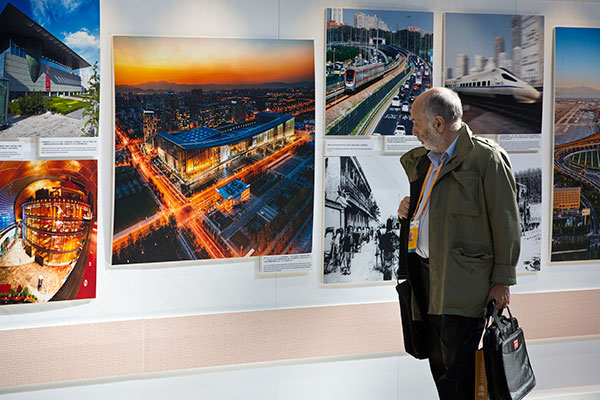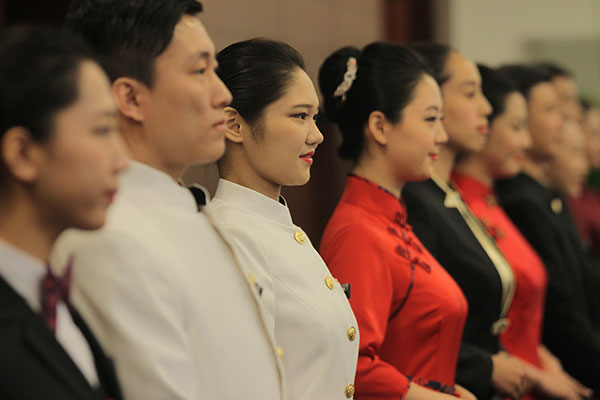
A foreign journalist looks into an exhibition about the evolution of the China National Convention Center, a main venue of the APEC meetings in Beijing. More than 4,000 journalists have registered to cover the events with a half of them from overseas.[Photo by Feng Yongbin/China Daily]
The China National Convention Center in Beijing will experience a few days of calm in early November before becoming the hive of activity during the 2014 APEC Economic Leaders’ Week.
Starting on Nov 5, six of the seven days of meetings will be held at the former Beijing Olympics facility, including the Concluding Senior Officials Meeting, the Ministerial Meeting, the APEC CEO Summit and the APEC Business Advisory Council Dialogue with Leaders.
The center, which has hosted numerous exhibitions, conventions and commercial activities, will also provide catering services to more than 73,000 people during the week.
The center has been preparing for the APEC events since October 2013. Its working groups have visited Indonesian island Bali as well as Chinese cities Shanghai, Ningbo and Qingdao to meet various event organizing committees and local convention center operators.
Liu Haiying, CEO of the China National Convention Center, said the CNCC has improved its facilities based on the demands of the APEC Economic Leaders’ Week, experience of catering to high-level events as well as the lessons they learned from these visits.
“We have improved our facilities in 108 aspects covering from restrooms, elevators, lighting to surveillance,” Liu said. “We didn’t redesign the place on a large scale. We were more focused on the details, making it more professional and friendlier to our guests.”

A chef at the China National Convention Center shows an APEC-themed cake.[Photo /China Daily]
Special rooms are set for delegates from different countries with different cultural backgrounds, such as a worship room for Muslims with the compass pointing west toward Mecca.
CNCC hired a third-party company to carry out the design for the improvements. Among all the 108 aspects, the surveillance service was specially tailored for the APEC week for security reasons.
“We have added more than 400 surveillance cameras which make it possible for us to monitor every corner within the center,” Liu said.
“It was also a good opportunity for us to maintain and upgrade our facility after five years of operation,” Liu said.
The center has also invested in training staff, designing new uniforms and coming up with new menus.
The catering service is one of CNCC’s strengths. Chun Botao, deputy director with CNCC’s event operation, said CNCC has adopted a very strict policy to ensure the quality of all ingredients and designed a featured tea break and dining menu which combines local food as well as other countries’ cuisines.

Waitresses at the China National Convention Center show their ironing skills at a demonstration in late October.[Photo /China Daily]
“For the tea break, with the help of our French executive chef, we have enriched the dim sum offerings and we will supply different tea breaks at different times according to our guests’ eating preferences,” Chun said.
“What APEC really brings to us is the recognition (of our capability) and the reputation after that,” Liu said. “CNCC was not the first choice of the organizing committee, but it is the final choice and will be the first choice of our potential clients in the future.”
CNCC was put into operation in 2009 after being one of the competition venues and the media center for the Beijing Olympic Games in 2008. The plenary hall on its fourth floor was the site for the fencing preliminaries and finals and the modern pentathlon, while the exhibition space on the first floor was used as the international broadcasting center.
The ballroom became the site for wheelchair fencing and boccie during the Beijing 2008 Paralympic Games.
“CNCC’s original design took into consideration its market positioning and function after the Olympic Games,” Liu said. “At the outset, CNCC’s management team conducted market research and came up with the convention-plus-exhibition design plan for the facility.
“Thanks to the far-sighted design, large-scale conventions and exhibitions can be held in the center simultaneously.”

Waiters and waitresses at the China National Convention Center line up for review in late October.[Photo by Wang Jing/China Daily]
CNCC is now one of the busiest convention centers in Beijing. By the end of October, it had hosted 3,918 conventions and events, 376 exhibitions, with the occupancy rate surpassing 80 percent. Among all the conventions and meetings, about 16 percent were international conventions, and about 12 percent had more than 1,000 participants.
“From the facilities, I am proud to say that we don’t have to do a lot of work because we have been capable of handling large-scale events from the start,” Liu said. “And CNCC is the first to provide a one-stop service which integrates functions such as conventions, exhibitions, entertainment, hotel, and dining experiences.”
Liu added that handling high-level events such as the APEC week can help the center to leverage its services.
“Unlike commercial events which would not have big adjustments after the contract is signed, high-level events especially political meetings tend to see changes all the time,” Liu said. “So it places a lot of challenges on operating the convention center. You have to deal with a lot of unexpected situations.”
Wu Shaoyuan, chief international conference expert of China M.I.C.E. Service Co, said hosting international events is a unique way for Beijing to develop its convention-plus-exhibition industry.
“In the 1980s, Beijing didn’t really have an international convention center,” Wu said.
“After the 1990 Asian Games, we turned the press center into the Beijing International Convention Center. And after 2008, we have CNCC. So hosting APEC has really given us another chance to develop the industry.”
NUMBERS
108 items renovated since October 2013
4,000 reporters registered at the media center with a half from overseas
100 meetings to be held, including the APEC CEO Summit, with more than 2,000 attending, to host banquet with 2,500 participants and to provide catering services for about 73,000
7,450 sets of LED lights installed inside expected to save 1.5 million kWh a year
31 trees and 1,070 square meters of grass planted
400 cameras added to cover all corners of the center
5,000 users will have access to Wi-Fi and 4G in the media center and conference area
